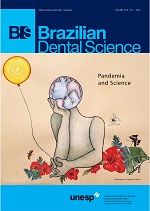Dental tooth decay profile in an institutionalized elder population of Northern Portugal
DOI:
https://doi.org/10.14295/bds.2020.v23i2.1940Abstract
Objectives: the purpose of this study was to assess the dental tooth decay profile of an elderly population from Northern Portugal. Material and Methods: this is a descriptive, cross-sectional study where a questionnaire, intended to assess the institutionalized elders oral health condition, was applied with the purpose of quantifying certain oral conditions. Tooth decay was assessed using the DMFT Index for the crown’s tooth and the individual radicular caries index (RCIi) for the root’s condition assessment. Univariate analysis and multivariable logistical regressions were performed (p < 0.05) using the IBM© SPSS© Statistics vs.19.0. Results: three hundred and seventy-two elderly participants were assessed with an average age of 78.8 years, of which 260 were women (69.9%). Of the sample 30.4% had no literacy and 18.3% were dependent on their daily oral hygiene care, 30.9% (95%CI:26.2%-35.6%) were edentulous and 84.9% (95%CI:81.3%-88.5%) had less than 20 teeth. The average number of teeth was 8.9 (±8.7) and the DMFT was 25.6 (± 7.3). The RCIi for men was 44.3% (± 30.4%) and 39.4% (± 31.2%) for women. Using multivariate logistical regression model the outcome RCIi?20% was shown to be significantly and positively associated with the use of removable partial dentures (metal partial dentures: OR=5.348 (95%CI:1.176-24,329; p = 0.030) as well as with daily tooth brushing (no toothbrushing: OR = 2.802 (95%CI:1.445-5.433); p = 0.002). Conclusion: the prevalence of tooth decay in this elder institutionalized population of Northern Portugal is high, mostly due to bad oral hygiene habits associated to the use of metal removable partial dentures. Institutionalized elderly need protocols tailored to their oral health needs and integrated efforts in the institutions are needed to effectively answer the demands related to the elderly cognitive and motor skills (ageing deterioration) decline of physiological functions.
KEYWORDS
Elderly; Oral health; Prosthesis; Root caries.
Downloads
Downloads
Additional Files
Published
How to Cite
Issue
Section
License
Brazilian Dental Science uses the Creative Commons (CC-BY 4.0) license, thus preserving the integrity of articles in an open access environment. The journal allows the author to retain publishing rights without restrictions.
=================




























